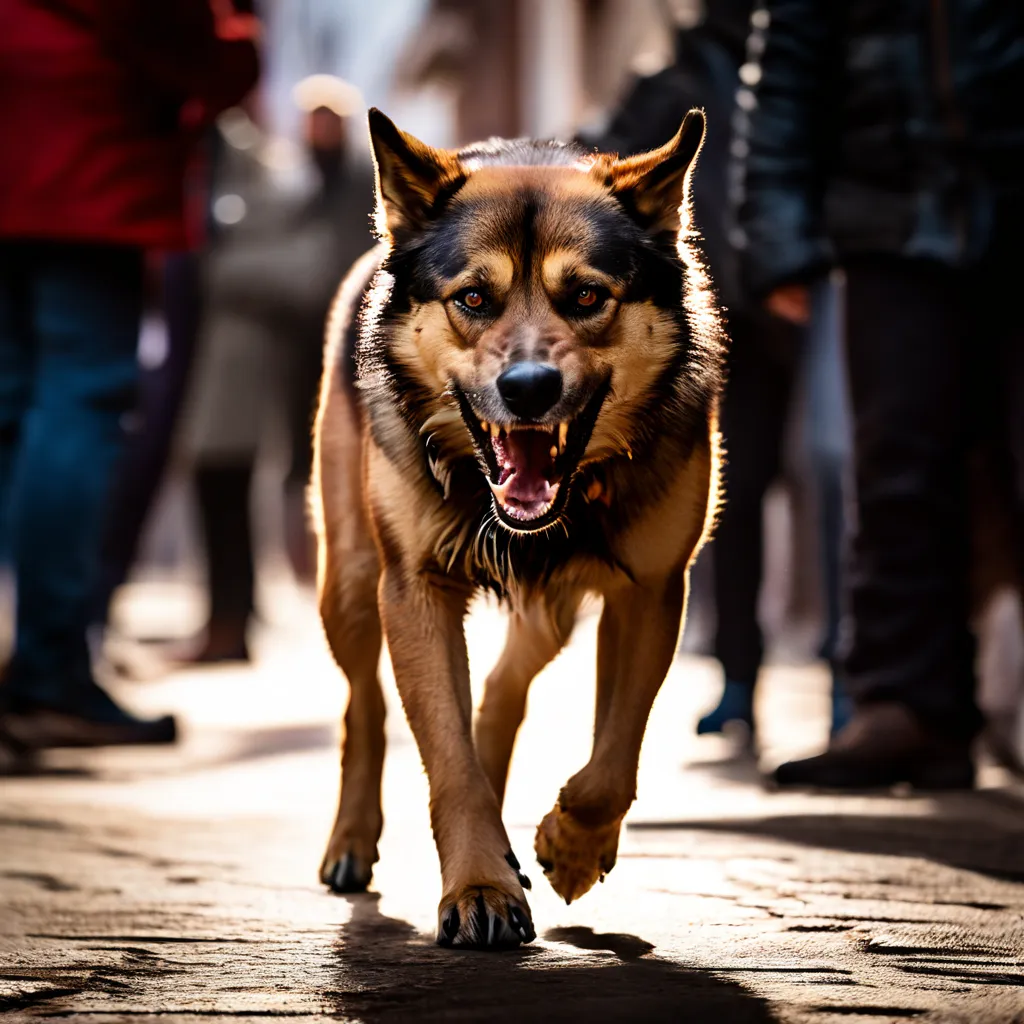Introduction
When it comes to canine companions, many of us assume that all dogs are friendly and loving. However, some breeds are more prone to aggression than others. But which breed takes the top spot as the most aggressive? According to experts, the answer lies in a combination of genetic and environmental factors.
In this article, we’ll delve into the world of canine aggression, exploring the role of genetics and environment in shaping a dog’s behavior, and identifying the breeds that are most likely to exhibit aggressive tendencies. From the powerful and intimidating to the small but fierce, we’ll examine the characteristics that make a dog more aggressive, and what you can do to prevent and reduce aggression through training and socialization. So, which breed is considered the most aggressive of them all? Let’s find out.

What Makes a Dog Aggressive?
Aggression in dogs is a complex issue that can stem from various factors. Understanding what makes a dog aggressive is crucial in preventing and addressing aggressive behavior.
Fear and Anxiety
Fear and anxiety are common causes of aggression in dogs. A dog may become aggressive when it feels threatened, scared, or trapped. This fear can be triggered by various stimuli, including loud noises, strangers, or new environments.
Pain and Discomfort
Pain and discomfort can also contribute to aggression in dogs. A dog in pain may lash out when touched or handled, even if it’s by its owner. This pain can be caused by underlying medical conditions, injuries, or arthritis.
Genetics and Breeding
A dog’s genetics and breeding can also play a role in its aggression. Some breeds, such as those bred for fighting or guarding, may be more prone to aggression due to their breeding history.
Socialization and Environment
A dog’s socialization and environment can also impact its aggression levels. A dog that is not properly socialized may become fearful or aggressive around strangers, while a dog that is exposed to violence or aggression may learn to mimic this behavior.
Medical Conditions
Certain medical conditions, such as neurological disorders or rabies, can also cause aggression in dogs.
Age and Sex
A dog’s age and sex can also influence its aggression levels. For example, geriatric dogs may become more aggressive due to cognitive decline, while intact male dogs may be more aggressive due to testosterone levels.

The Role of Genetics in Aggression
Genetics play a significant role in aggression in dogs. Research has shown that certain breeds are more prone to aggression due to their genetic makeup. Studies have identified specific genes that contribute to aggressive behavior, such as the chromosome 13 risk haplotype, which is associated with increased fear, anxiety, and aggression traits.
Genetic factors can influence a dog’s temperament, making them more likely to exhibit aggressive behavior. For example, some breeds have been bred for specific traits, such as guarding or fighting, which can increase their aggression levels. Additionally, genetic predispositions can affect a dog’s response to environmental stimuli, leading to aggressive behavior.
Studies have also found that genetics can account for 60 to 70 percent of the variation in aggression traits, such as fear and anxiety. This suggests that genetics play a significant role in shaping a dog’s aggressive behavior.
It’s essential to note that genetics is not the sole contributor to aggression in dogs. Environmental factors, such as training and socialization, also play a crucial role in shaping a dog’s behavior. Understanding the interplay between genetics and environment is crucial in identifying and addressing aggressive behavior in dogs.
The Role of Environment in Aggression
The environment plays a significant role in shaping a dog’s aggressive behavior. Research suggests that exposure to violence, ambient air pollution, and ambient noise can increase aggressive behavior in dogs. Additionally, individual experiences, such as nonshared environmental factors, can cause siblings to differ in their levels of aggressive behavior.
Environmental factors, such as circumstances and challenges in a dog’s everyday life, can also contribute to aggressive behavior. For example, physical discomfort, poor communication, and an uncomfortable environment can all trigger aggression in dogs.
Furthermore, the environment can affect a dog’s behavior by influencing its social cues. For instance, a dog that is exposed to violence in its environment may be more likely to exhibit aggressive behavior.
It is essential to recognize the impact of environment on a dog’s aggression and take steps to create a comfortable and safe environment that promotes positive behavior. This can include providing a stable and loving home, socializing a dog properly, and addressing any underlying issues that may be contributing to aggressive behavior.

Interplay Between Genetics and Environment
The interplay between genetics and environment plays a crucial role in shaping a dog’s behavior, including aggression. While genetics may predispose a dog to behave in certain ways, environmental factors can influence the expression of those behaviors. In other words, a dog’s genetics sets the stage, but the environment directs the play.
Research has shown that genetic variation in aggression-related traits can affect a dog’s behavior, but it is not the sole determining factor. Environmental factors, such as socialization, training, and life experiences, can interact with a dog’s genetics to influence its behavior. For example, a dog that is genetically prone to aggression may become more aggressive if it is exposed to violent or abusive environments.
On the other hand, a dog that is genetically predisposed to be friendly may become more aggressive if it is not socialized properly or is exposed to stressful environments. This complex interaction between genetics and environment is dynamic and can change over time, making it challenging to predict a dog’s behavior based on genetics alone.
Studies have also shown that the interaction between genetics and environment can influence the prevalence of canine behavior problems, including aggression. For instance, a study found that genetic variation in aggression-related traits in Golden Retriever dogs interacted with environmental factors to influence the development of behavior problems.
In conclusion, the interplay between genetics and environment is a critical factor in understanding dog aggression. By recognizing the complex interaction between these two factors, we can develop more effective strategies for preventing and reducing aggression in dogs.
Identifying the Most Aggressive Breeds
When it comes to identifying the most aggressive dog breeds, it’s essential to consider various factors, including their natural instincts, temperament, and historical purpose. While any dog can become aggressive with improper training and socialization, some breeds are more prone to aggression due to their genetic makeup and original breeding purposes.
Top 5 Most Aggressive Dog Breeds
- Dachshunds: Originally bred to hunt badgers, dachshunds are known for their fearless and territorial nature, making them one of the most aggressive breeds towards people and other animals.
- Rottweilers: With their powerful build and natural protective instincts, Rottweilers can become aggressive if not properly trained and socialized.
- German Shepherds: As one of the most popular breeds, German Shepherds are often used as guard dogs, which can lead to aggression if they’re not properly trained to distinguish between threats and non-threats.
- Chow Chows: With their independent nature and strong prey drive, Chow Chows can become aggressive towards strangers and other animals if not socialized properly.
- American Pitbull Terriers: Originally bred for bloodsports, American Pitbull Terriers have a strong prey drive and can become aggressive if not trained and socialized correctly.
Other Breeds to Consider
- Chihuahuas: Known for their big ears and small size, Chihuahuas can become aggressive due to their territorial nature and fear of strangers.
- Doberman Pinschers: With their sleek build and intelligent nature, Doberman Pinschers can become aggressive if not properly trained and socialized.
- Cane Corsos: Originally bred as guard dogs, Cane Corsos can become aggressive towards strangers and other animals if not trained correctly.
Remember
Aggression in dogs is not solely determined by breed. Proper training, socialization, and care can help prevent aggression in any dog, regardless of breed. It’s essential to research a breed’s temperament and needs before bringing one home.
Preventing and Reducing Aggression through Training and Socialization
Preventing and reducing aggression in dogs requires a combination of training, socialization, and responsible dog ownership. While genetics play a significant role in aggression, environment and upbringing also have a profound impact on a dog’s behavior.
Early Socialization
Socialization is critical in preventing aggression in dogs. Puppy classes have been proven to reduce the occurrence of aggression in dogs by helping to socialize them early on. Socialization should start early and continue throughout a dog’s life.
Training
Training is essential in preventing and reducing aggression in dogs. Positive reinforcement training methods can help to curb territorial aggression and prevent behavioral problems. Desensitization and stress inoculation can also help to prevent aggression in dogs.
Neutering/Spaying
Neutering or spaying a dog can help to curb territorial aggression and prevent unwanted breeding. This can also help to reduce aggression in dogs.
Responsible Dog Ownership
Responsible dog ownership, including proper training and socialization of dogs, can help to prevent aggression. Dog owners should be aware of their dog’s behavior and take steps to prevent aggression, such as separating dogs during high-risk times.
Conclusion
After exploring the various factors that contribute to aggression in dogs, including genetics, environment, and the interplay between the two, it’s clear that aggression is a complex issue that cannot be attributed to a single breed or factor. However, based on various studies and data, it appears that some breeds are more prone to aggression than others.
According to the American Temperament Test Society, Inc. (ATTS) data, the top 10 most aggressive dog breeds include:
- Chihuahua
- Dachshund
- Chow Chow
- Akita
- American Pitbull Terrier
- Cane Corso
- Doberman Pinschers
- Rottweilers
- German Shepherds
- Rough Collies
It’s essential to note that aggression is not inherent to any breed and can be influenced by various factors, including training, socialization, and environment. Additionally, while some breeds may be more prone to aggression, it’s crucial to remember that every dog is an individual, and their behavior is shaped by a combination of genetic and environmental factors.
Ultimately, the most aggressive dog breed is not necessarily a specific breed, but rather a dog that has been poorly trained, socialized, or cared for. By understanding the factors that contribute to aggression and taking steps to prevent and reduce aggression through training and socialization, we can work towards creating a safer and more harmonious environment for both humans and dogs.

By acknowledging the complexities of aggression and taking a comprehensive approach to addressing it, we can promote a better understanding of canine behavior and work towards a future where dogs are valued and respected members of our society.
References
- https://www.akc.org/expert-advice/training/puppy-socialization
- https://www.petmd.com/dog/behavior/aggression-in-dog
- https://www.aspca.org/pet-care/dog-care/common-dog-behavior-issues/aggressio
- https://pethelpful.com/dogs/worlds-most-aggressive-dog-breed
- https://www.researchgate.net/publication/40101976_Genetic_variation_in_aggression-related_traits_in_Golden_Retriever_dog
















